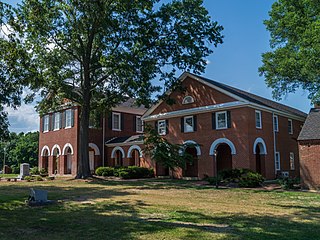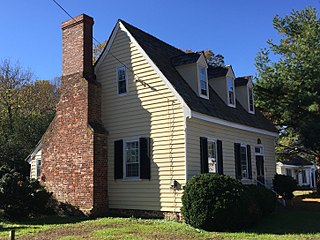
Middlesex County is a county located on the Middle Peninsula in the U.S. state of Virginia. As of the 2020 census, the population was 10,625. Its county seat is Saluda.

Four Mile Tree is the name of a plantation near Jamestown, Virginia that once encompassed two thousand acres (8 km2), it was situated on the south bank of the James River opposite Jamestown, four miles (6 km) further north. On a hill near the water's edge a handsome old house overlooks the river. This plantation, was the seat of the Browne family for two hundred years. The first owner, Colonel Henry Browne, was a member of Sir William Berkeley's Council in 1643. The plantation house constructed circa 1745 remains well-preserved in its original historical state.

Philip Cottington Ludwell was an English-born planter and politician in colonial Virginia who sat on the Virginia Governor's Council, the first of three generations of men with the same name to do so, and briefly served as speaker of the House of Burgesses. In addition to operating plantations in Virginia using enslaved labor, Ludwell also served as the first governor of the Carolinas, during the colony's transition from proprietary rule to royal colony.
Robert Beverley Jr. was a historian of early colonial Virginia, as well as a planter and politician.

Sabine Hall is a historic house located near Warsaw in Richmond County, Virginia. Built about 1730 by noted planter, burgess and patriot Landon Carter (1710–1778), it is one of Virginia's finest Georgian brick manor houses. Numerous descendants served in the Virginia General Assembly. It was added to the National Register of Historic Places in 1969, and declared a National Historic Landmark in 1970. At the time of its National Register listing, it was still owned by Carter / Wellford descendants.

Dogham Farm, previously known as Doggams, is a historic home and farm located in Charles City, Charles City County, Virginia. In 1642, Joseph Royall patented 600 acres on the north side of the James River in Charles City County. The plantation he named "Doggams" later became known as "Dogham" in the 18th century. Following the death of Joseph Royall, his widow married Henry Isham. Dogham is notable not only for its antiquity but also for its continuous ownership and occupation by the same family - the property remains in the Royall and Isham lines today.

Wormeley Cottage, also known as the Wormeley-Montague House, is a historic home located at Urbanna, Middlesex County, Virginia. One of the few remaining 18th century buildings, it was built on orders of Ralph Wormeley about 1750, when the port town was established. He sold several town lots, including the cottage, in 1770 to James Mills.
Christopher Robinson was a planter, merchant and politician in the British colony of Virginia. Robinson held several public offices in Colonial Virginia and is the patriarch in America for one of the First Families of Virginia.
Robert Wormeley Carter was a Virginia planter and patriot who served in the House of Burgesses, all five Virginia Revolutionary Conventions, and briefly in the Virginia House of Delegates, all representing his native Richmond County.
Sir Henry Chicheley was a lieutenant governor of Virginia Colony who also served as Acting Governor during multiple periods in the aftermath of Bacon's Rebellion. Having first visited the Virginia colony as a Royalist in exile, where he served in the House of Burgesses in violation of his probation, Lt. Gov. Chicheley wielded power during a period of sociopolitical turmoil and change, and later in his career was increasingly troubled by England's growing aggression and control over the colony.
Sir Richard Kemp was a planter and politician in the Colony of Virginia. Kemp served as the Colony's Secretary and on the Governor's Council from 1634 to 1649. As the council's senior member, he also served as the acting Colonial Governor of Virginia from 1644 to 1645 during travels by Governor Sir William Berkeley. Kemp had also worked closely relation with Berkeley's predecessor, Sir John Harvey.
Ralph Wormeley emigrated to the Virginia colony, where he became a planter and politician who represented York County in the House of Burgesses and developed Rosegill plantation in what became Middlesex County after his death.
Ralph Wormeley Jr. (1651-1701) was a planter and politician who represented Middlesex County in the House of Burgesses before being elevated to the Virginia Governor's Council and serving as the colony's secretary and briefly as its acting governor. He further developed his father's Rosegill plantation, now on the National Register for Historic Places, as well as operated several plantations in adjoining Tidewater counties using enslaved labor.

Ralph Wormeley who like his namesake grandfather was a planter and politician who represented Middlesex County in the House of Burgesses. He and his bookloving and loyalist son also operated Rosegill plantation, now on the National Register for Historic Places, using enslaved labor.

Ralph Wormeley was a Virginia planter who served as a member of the Governor's Advisory Council (1771-1775), was suspected of being a Loyalist during the American Revolutionary War, and after the conflict represented Middlesex County, Virginia in the Virginia House of Delegates (1788-1791) as well as at the Virginia Ratifying Convention of 1788, where he voted in favor of ratification of the federal Constitution.
Gawin Corbin Jr., although trained as a lawyer in England, became a Virginia planter, loyalist militia officer, customs collector and politician who served in both chambers of the Virginia General Assembly as had his father Richard Corbin.
Gawin Corbin (1669-1745) was a Virginia planter, militia officer, customs collector and politician who served in the House of Burgesses representing at various times Middlesex and King and Queen County. Two descendants of the same name would also serve in the House of Burgesses, Gawin Corbin Sr. and Gawin Corbin Jr.
William Churchill (1649-1710) emigrated from England and became a Virginia merchant, planter and politician who twice briefly served in the House of Burgesses representing Middlesex County, Virginia, and on the Virginia Governor's Council (1705-1710).
Christopher Wormeley was a British military officer who served as governor of Tortuga before becoming the secretary of state for the Virginia Colony (1635-1649) as well as captain of the fort at Old Point Comfort beginning in 1638. He also served on the Virginia Governor's Council (1637-1642), as would his younger brother Ralph Wormeley Sr. and son Christopher Wormeley Jr.
Dudley Digges was a Virginia attorney, planter, military officer and politician who served in the House of Burgesses (1752-1776) and all the Virginia Revolutionary conventions representing York County. Possibly the most famous of three related men of the same name who served in the Virginia legislature during the 18th century, this man was the third son of Yorktown merchant Cole Digges who served in both houses of the Virginia legislature.












